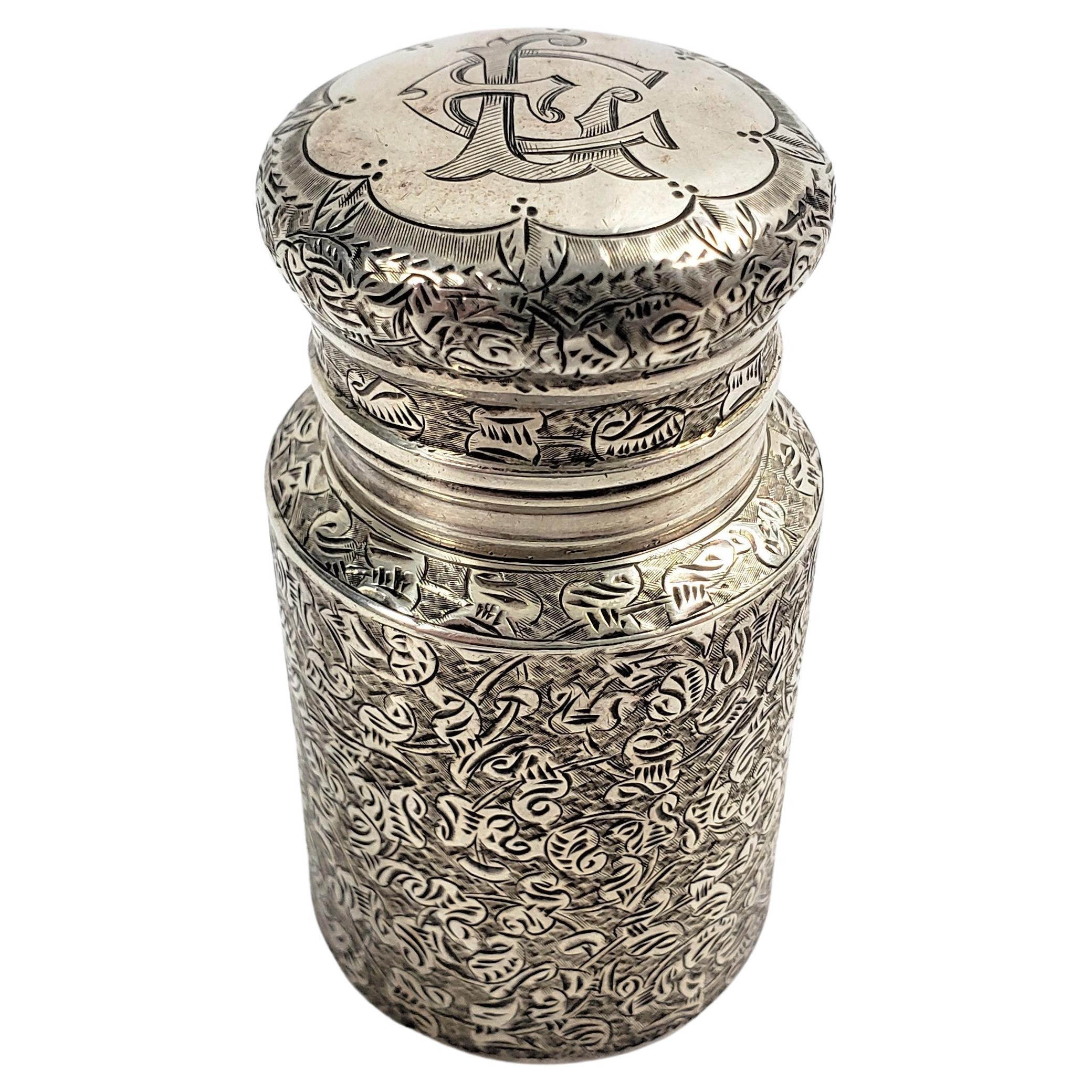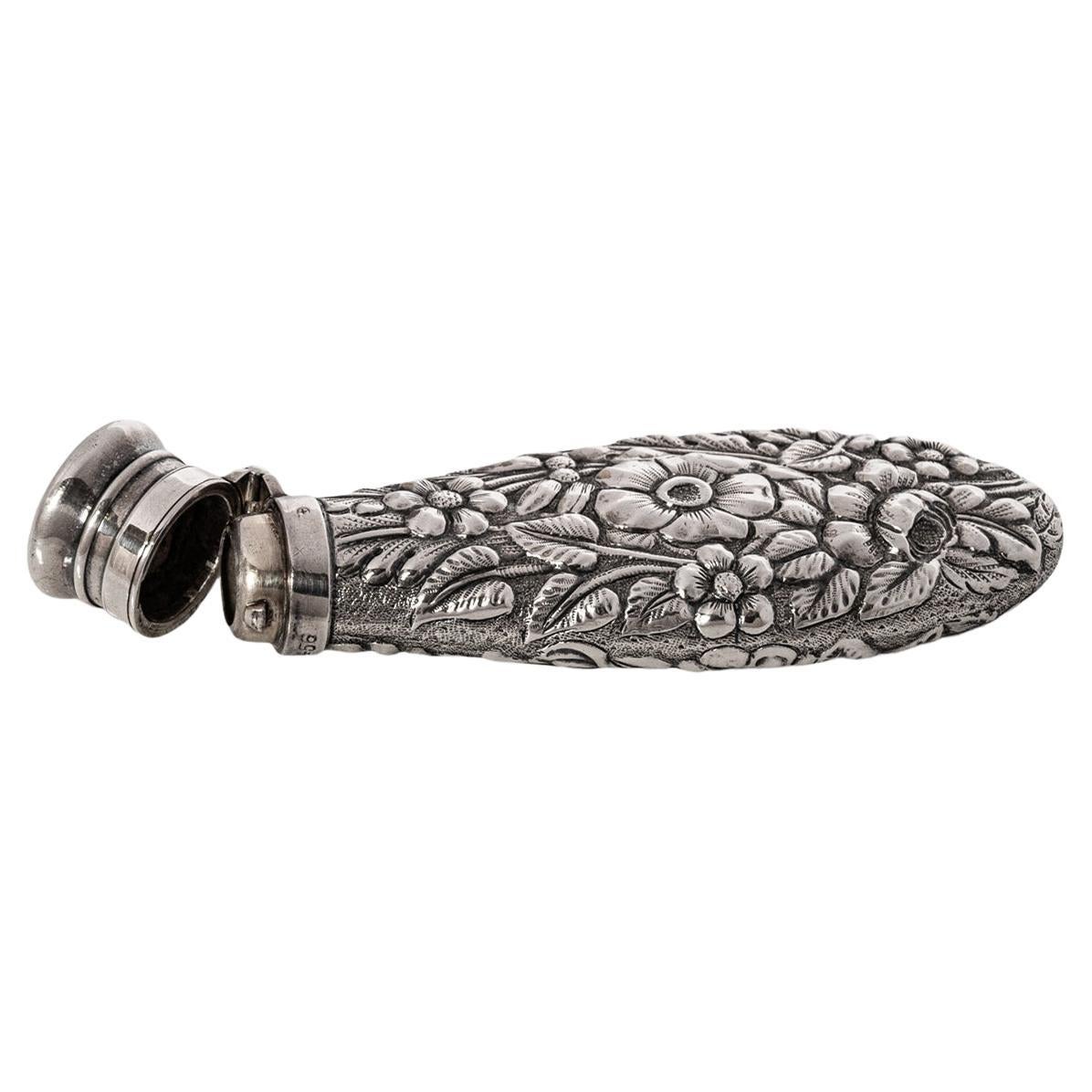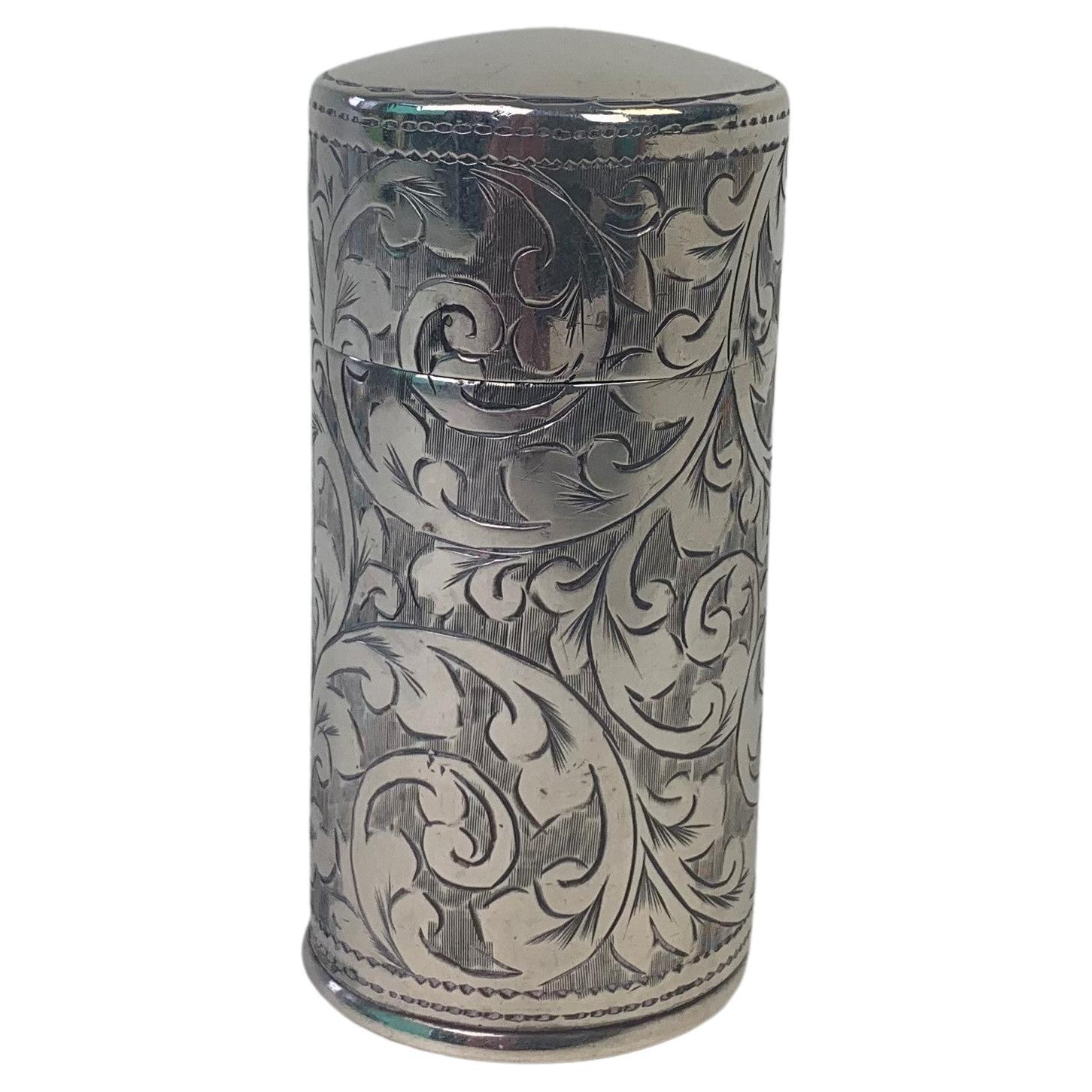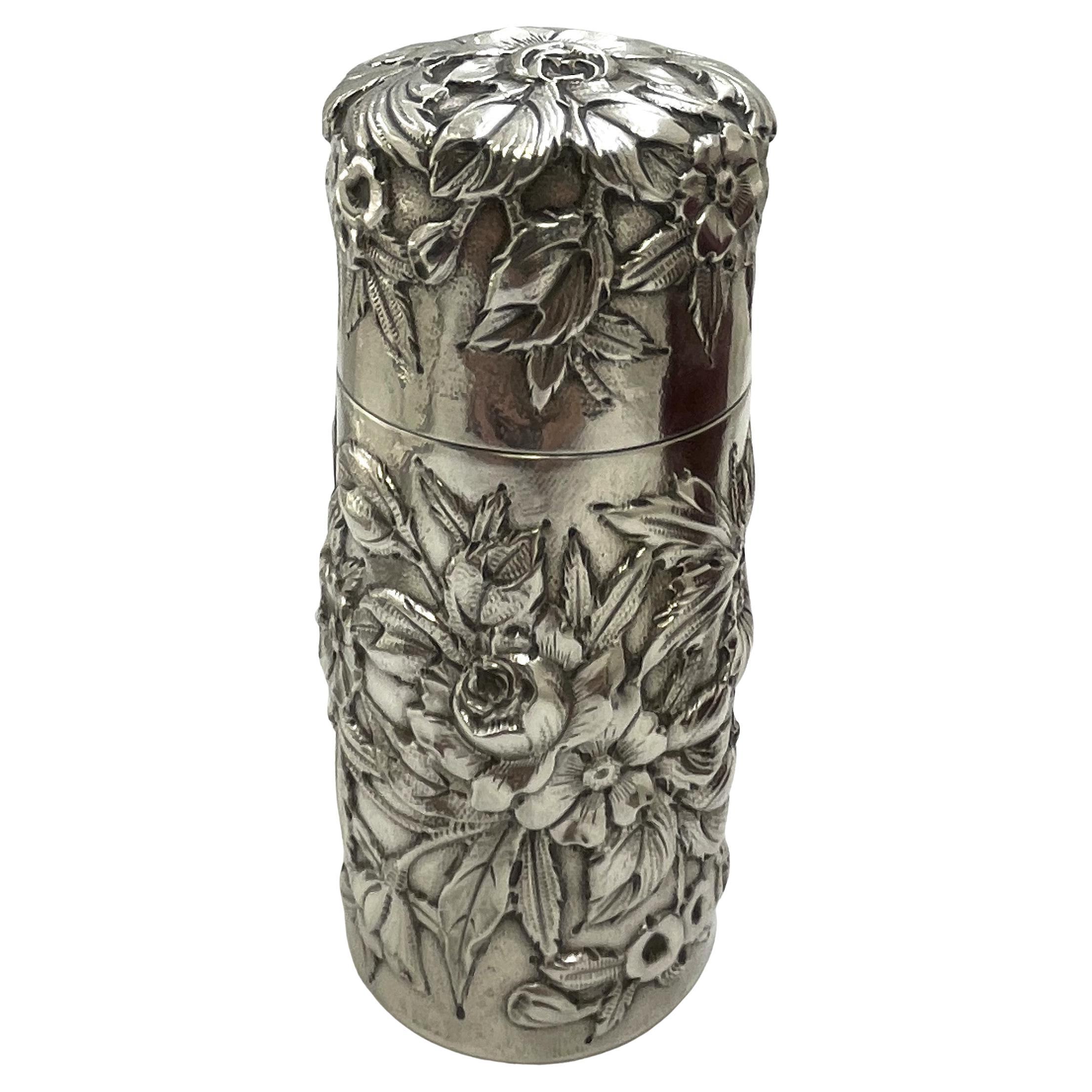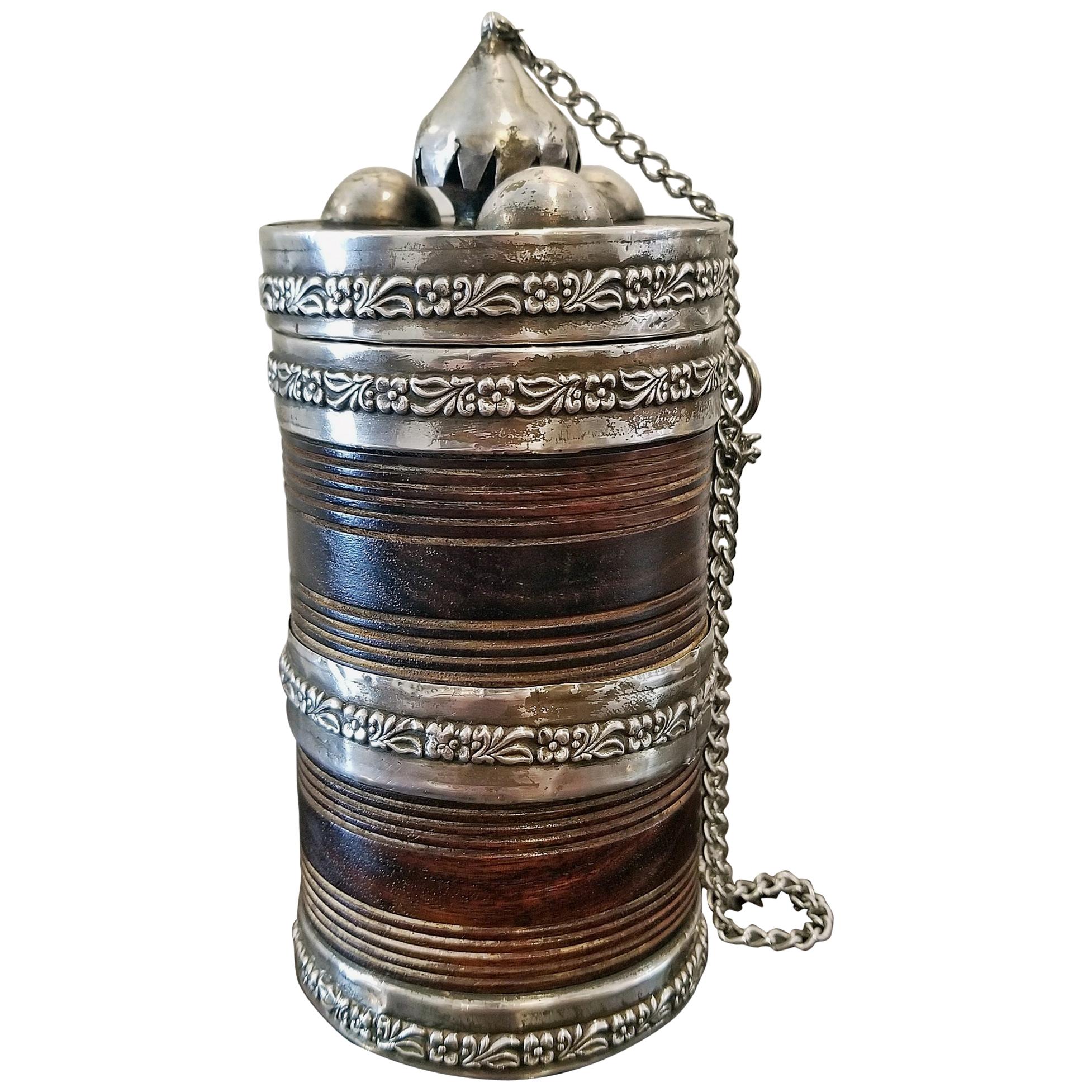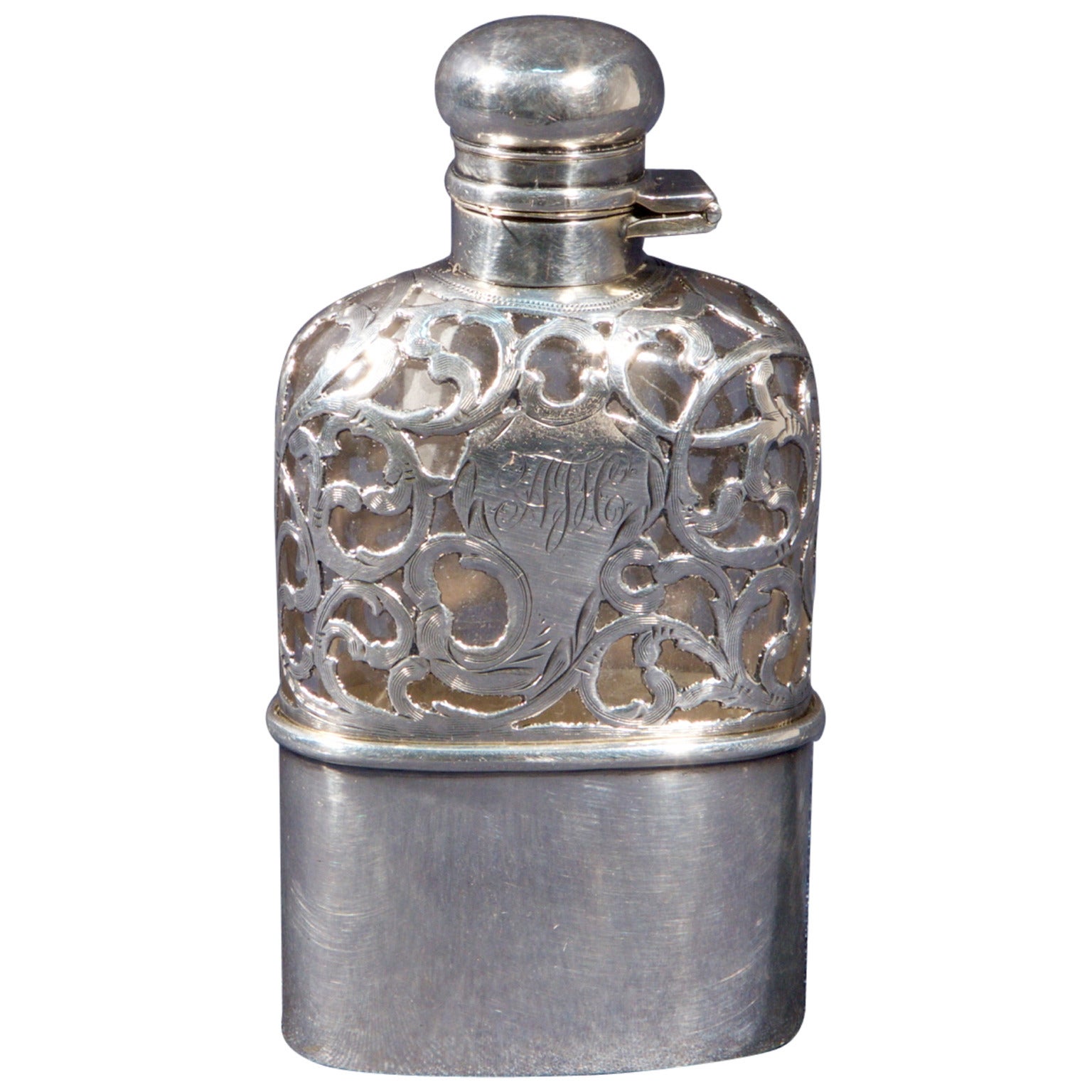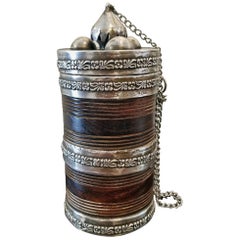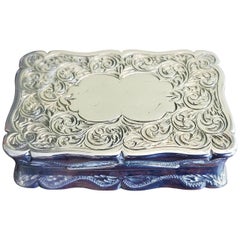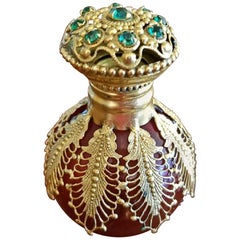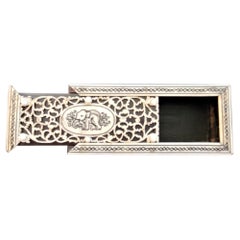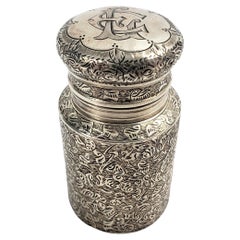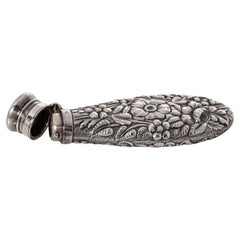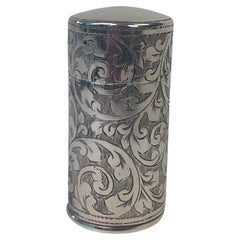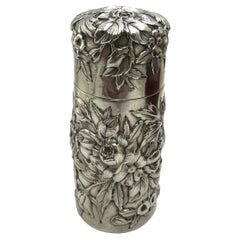Items Similar to 19C Anglo Indian Silver Perfume Bottle Case
Want more images or videos?
Request additional images or videos from the seller
1 of 13
19C Anglo Indian Silver Perfume Bottle Case
$240
£180.98
€209.32
CA$336.72
A$374.28
CHF 196.19
MX$4,570.91
NOK 2,449.34
SEK 2,304.37
DKK 1,562.28
About the Item
19C Anglo Indian solid silver perfume bottle case.
Lovely 19th century Anglo-Indian solid silver perfume bottle case with profuse repousse work.
Not hallmarked because it was made in Colonial India, but solid silver and beautifully made.
Both the Base and the lid have blank cartouches’ for personalized engraving. This is an advantage as you can have them engraved personally if you wish !!
An elegant lady would place her perfume bottle inside !
From Circa 1880, the time of the raj !!
- Dimensions:Height: 4.5 in (11.43 cm)Diameter: 1.85 in (4.7 cm)
- Style:Anglo Raj (Of the Period)
- Materials and Techniques:Sterling Silver,Repoussé
- Place of Origin:
- Period:
- Date of Manufacture:1880
- Condition:Wear consistent with age and use. Minor structural damages. Very good original condition. One or two very minor indents.
- Seller Location:Dallas, TX
- Reference Number:1stDibs: LU3978124943642
About the Seller
4.9
Gold Seller
Premium sellers maintaining a 4.3+ rating and 24-hour response times
Established in 2015
1stDibs seller since 2018
393 sales on 1stDibs
- ShippingRetrieving quote...Shipping from: Dallas, TX
- Return Policy
Authenticity Guarantee
In the unlikely event there’s an issue with an item’s authenticity, contact us within 1 year for a full refund. DetailsMoney-Back Guarantee
If your item is not as described, is damaged in transit, or does not arrive, contact us within 7 days for a full refund. Details24-Hour Cancellation
You have a 24-hour grace period in which to reconsider your purchase, with no questions asked.Vetted Professional Sellers
Our world-class sellers must adhere to strict standards for service and quality, maintaining the integrity of our listings.Price-Match Guarantee
If you find that a seller listed the same item for a lower price elsewhere, we’ll match it.Trusted Global Delivery
Our best-in-class carrier network provides specialized shipping options worldwide, including custom delivery.More From This Seller
View All19th Century Anglo-Indian Spice or Tea Caddy with Silver Mounts
Located in Dallas, TX
PRESENTING A GORGEOUS 19C Anglo Indian Rosewood Caddy with Silver Mounts.
Really nice and unusual, 19th Century Anglo-Indian Spice or Tea Caddy, from cir...
Category
Antique Late 19th Century Indian Anglo Raj Tea Caddies
Materials
Sterling Silver
19th Century Sterling Silver Snuffbox Birmingham 1848 by Rolason Bros
By Rolason Brothers
Located in Dallas, TX
Lovely little sterling silver snuffbox, fully hallmarked with gold plated interior.
Lovely chasing on lid and sides, classic high Victorian repousse w...
Category
Antique Mid-19th Century English High Victorian Sterling Silver
Materials
Sterling Silver
$426 Sale Price
67% Off
18th Century French Palais Royal Perfume Bottle
Located in Dallas, TX
PRESENTING AN ABSOLUTELY STUNNING Perfume/Scent Bottle from the 18th Century, namely an 18C French Palais Royal Perfume Bottle. .
Either French o...
Category
Antique Late 18th Century French Louis XVI Bottles
Materials
Tourmaline, Gold
19C Anglo Indian Vizigapatam Stamp Box
Located in Dallas, TX
Presenting an absolutely gorgeous and very rare 19C Anglo Indian Vizigapatam stamp box.
Made in Colonial India (the Time of the Raj) circa 1860.
Prob...
Category
Antique Mid-19th Century Indian Anglo-Indian Decorative Boxes
Materials
Bone, Shell
19C Anglo Indian Vizagapatam Bone and Shell Domed Stationery Box
Located in Dallas, TX
PRESENTING A LOVELY 19C Anglo Indian Vizagapatam Bone and Shell Domed Stationery Box – ‘Alice’s Box’.
Made in Vizagapatam, India, circa 1860-80.
We call this one: “Alice’s Box”! It has lived ‘a hard, well used and traveled life’, as is evident from the number of losses and repairs, as is obvious from the photos, especially to the faux ivory panels and bands to the top. The bonus to the loss of the frieze panels to the dome has a ‘bonus’, however, as their loss has revealed the most GORGEOUS faux blonde tortoiseshell underneath!
The box is dome/casket shaped.
The top has 3 bands, with the center one being the original. The 2 side bands are later ivorine.
The faux ivory and hand-painted medallions on the domed lid, have been saved and they depict Hindu Gods, Vishnu and Shiva.
The front and side panels are still in pretty good shape and are decorated with lac ink (indelible ink made from crushed beetles) depicting lovely floral designs.
The domed lid open to reveal a series of open compartments for envelopes, writing paper etc. and one lidded panel for stamps.
Inside the box are 2 paper labels: one probably being the original item ticket and the other with:
” Alice’s address is 272 Ashworth Ave, Toronto 4, Ontario”.
Probably, the original owner? Hence, we call it ‘Alice’s Box’.
What a journey/life this box has had!
Made in India, made its way to Canada, back to Ireland and then to Texas!
This is why, WE LOVE ANTIQUES...
Category
Antique 19th Century Indian Anglo-Indian Decorative Boxes
Materials
Bone, Shell, Sandalwood
Japanese Meiji Period Sterling Silver 2 Handled Basket by Katsu Miyamoto
By Miyamoto Shoko 1
Located in Dallas, TX
PRESENTING a GORGEOUS, VERY HIGH QUALITY and EXTREMELY RARE piece of Japanese Meiji Period Sterling Silver 2 Handled Basket by Katsu Miyamoto.
EXQUISITE, EXCEPTIONAL, RARE & IMPORTANT!
This is definitely a Meiji Period piece due to the fact that it is marked with the sterling silver mark “jungin”.
The Meiji period was from 1868 to 1912 and in 1928 a law was introduced in Japan compelling the use of decimal marks for silver.
This pre-dates that decimalization law.
We are of the opinion that it is from circa 1900.
Miyamoto Shoko was founded in 1880 as the first silverware specialty shop. In 1899, Miyamoto Shoko’s silverwares were ordered by the family members of the Emperor of Japan, and to this day, they are making fine and graceful handicrafts with skillful craftsmen.
Loved by numerous customers since the Meiji era, Miyamoto Shoko’s products have also been given to Princess Mako and Princess Kako of Akishino, as well as Princess Aiko Toshinomiya, on their birthdays.
Katsu Miyamoto (宮本勝), in 1880, in order to increase the sales of tobacco and cigarettes to foreigners founded the Moyamoto Shoko company, which produced different silverwares in general and particularly silver cigarette cases. Miyamoto’s first name, Katsu (勝) in some sources is written as “Masaru”, since 勝 kanji can be pronounced in both ways.
This basket is of the HIGHEST QUALITY imaginable!
The top of the basket has the MOST GORGEOUS repousse work of flowers, probably lotus flowers, with leaves and foliage. It has an underlying chevron effect chasing, reflecting parquetry.
The 2 handles are cast in the form of bamboo handles.
The rim of the top likewise is cast as bamboo.
The base is equally stunning in a different way!
It is chased with a chevron effect, like parquetry flooring and the four feet simulate pieces of sliced bamboo with an interlinking gallery of support columns, likewise, simulating bamboo.
The QUALITY of WORKMANSHIP is OUTSTANDING!
The pieces weighs exactly 525 grams.
This piece takes my breath away!
This is one for the SERIOUS COLLECTOR of EXQUISITE AND RARE Japanese silver. You will not find another like it, for sale ANYWHERE ELSE IN THE WORLD …… I know as I have searched!
Provenance: Acquired from a Dallas Private Collector.
Dimensions: 9.6 inches wide, 7.6 inches deep and 2.75 inches tall ( 7.25 inches tall with handles up)
Condition: Very good. It looks like the base 4 legged gallery, has been repaired/re-attached to the base, but otherwise it is excellent and of Museum quality.
The Meiji period (明治時代 Meiji-jidai?), also known as the Meiji era, is a Japanese era which extended from October 23, 1868 through July 30, 1912.[1] This period represents the first half of the Empire of Japan during which Japanese society moved from being an isolated feudal society to its modern form. Fundamental changes affected its social structure, internal politics, economy, military, and foreign relations. The period corresponded with the reign of Emperor Meiji after 1868, and lasted until his death in 1912. It was succeeded by the Taishō period upon the accession of Emperor Taishō to the throne.
Solid silver pieces...
Category
Early 20th Century Japanese Meiji Metalwork
Materials
Sterling Silver
You May Also Like
Antique Sterling Silver Scent or Perfume Bottle with Chased Decoration
Located in Hamilton, Ontario
This antique perfume bottle is signed by an unknown English maker and dates to approximately 1898 and done in the period Victorian style. The bottle is done in sterling silver with a...
Category
Antique Late 19th Century English Victorian Bottles
Materials
Sterling Silver
Antique Sterling Silver Perfume Scent Engraved Repousse Bottle Flask London 1873
Located in Portland, OR
A very elegant antique 19th century repousse work sterling silver perfume flask, London, 1873.
The circular top twists and locks in plac...
Category
Antique 1870s English High Victorian Sterling Silver
Materials
Sterling Silver
Silver Cased Scent Bottle
Located in Folkestone, GB
A fine quality silver cased scent bottle engraved with scrolling leafy decoration. The snap-shut hinged lid enclosing the original glass stopper which fit...
Category
Early 20th Century English Sterling Silver
Materials
Silver
S. Kirk & Son & Co Sterling Silver Repousse Spice Box Besamim from 1903-1924
By S. Kirk & Sons
Located in New York, NY
S. Kirk & Son & Co. sterling silver besamim spice box in repousse pattern, adorned with floral and natural motifs, made between 1903 and 1924. It mea...
Category
Early 20th Century American Sterling Silver
Materials
Silver, Sterling Silver
Sterling Silver and Glass Whiskey Pocket Flask, 1920s
Located in Alessandria, Piemonte
American (or English ?) pocket flask of whiskey in silver sterling and glass, with initials -
Punched J.B. Caldwell & Co - An idea for a beautiful gift.
....
Category
Early 20th Century English Late Victorian Sterling Silver
Materials
Silver
S. Kirk & Son Sterling Silver Repousse Besamim Spice Box from 1903-1907
By S. Kirk & Sons
Located in New York, NY
S. Kirk & Son & Co. sterling silver besamim spice box in repousse pattern, adorned with floral and natural motifs, made between 1903 and 1907. It mea...
Category
Antique Early 1900s American Sterling Silver
Materials
Silver, Sterling Silver
More Ways To Browse
Cased Silver
Antique Sterling Silver Perfume
Sterling Silver And Glass Perfume
India Repousse
Silver Perfume Bottles
Colonial Indian Silver
Anglo Indian Colonial Raj
Round Sterling Silver Tray
Sterling Silver By Whiting
800 German Sterling Silver
Antique Gorham Sterling Silver Flatware
Antique Silver Sauce Ladle
English Silver Fish
Norwegian Enamel
Rare Antique Knife
Sterling Silver With M Monogram
Antique Sterling Silver Perfume
Georg Jensen Silver 1919
